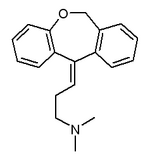A 46-year-old woman presented with a chief complaint of dizziness, which had begun approximately 16 years earlier and had recurred 8 or 9 times. Her spells lasted from a day up to a few weeks. The first episode was associated with food allergy. She described the sensation as a feeling that she was being pulled to the right; during these episodes, she did not feel well and she noted a decrease in her ability to concentrate and a problem with her memory. She said she sometimes felt as if the floor were only 16 inches away. In terms of balance, she likened herself to a puppet on a string being pulled to the right. During the previous week, she had experienced a spell of room-spinning while she was smoking a cigarette. Some of her symptoms were triggered by exercising and were intensified when she had taken doxepin.
The patient was occasionally sensitive to loud sound, but she reported no subjective hearing loss. During the preceding 2 weeks, tinnitus had occurred twice; each episode had lasted a few minutes. The tinnitus was equal in both ears, and she described it as "white-noise sound" or "empty-room sound." She reported no aural fullness or headaches. She had recently been diagnosed with an autoimmune disease, and she was taking prednisone and doxepin. She had also been on thyroid hormone replacement therapy for 2 years for the treatment of Graves' disease and the hypothyroidism associated with it. There was a family history of dizziness (her mother) and hearing loss (her father). Clinical examination revealed an inability to perform the Romberg's test.
Electronystagmography detected a 5[degrees]/sec left-beating spontaneous nystagmus. Elements of the nystagmus as seen on simultaneous recordings revealed a central dysrhythmic pattern. The alternate binaural bithermal (ABB) caloric test, when corrected for the preexisting nystagmus, did not induce any left-beating nystagmus. This test revealed a 100% directional preponderance to the right and no significant reduced vestibular response.
The simultaneous binaural bithermal (SBB) test showed only the preexisting spontaneous nystagmus, and therefore there was no caloric-induced response to either the cool or warm simultaneous stimulus. Findings on audiometry were normal, and contrast-enhanced magnetic resonance imaging (MRI) was negative.
This case illustrates the ability of electronystagmography to demonstrate a vestibular abnormality. An abnormal vestibular system was made evident by the spontaneous nystagmus during the ABB test. A failure to correct for preexisting nystagmus during caloric tests might have suggested misleading diagnostic possibilities. Taking the correction into consideration, the SBB test did not add any useful diagnostic information. The MRI had ruled out a pathologic central nervous system disorder, and the medical diagnosis suggested an autoimmune basis for her symptoms.
COPYRIGHT 2005 Medquest Communications, LLC
COPYRIGHT 2005 Gale Group



